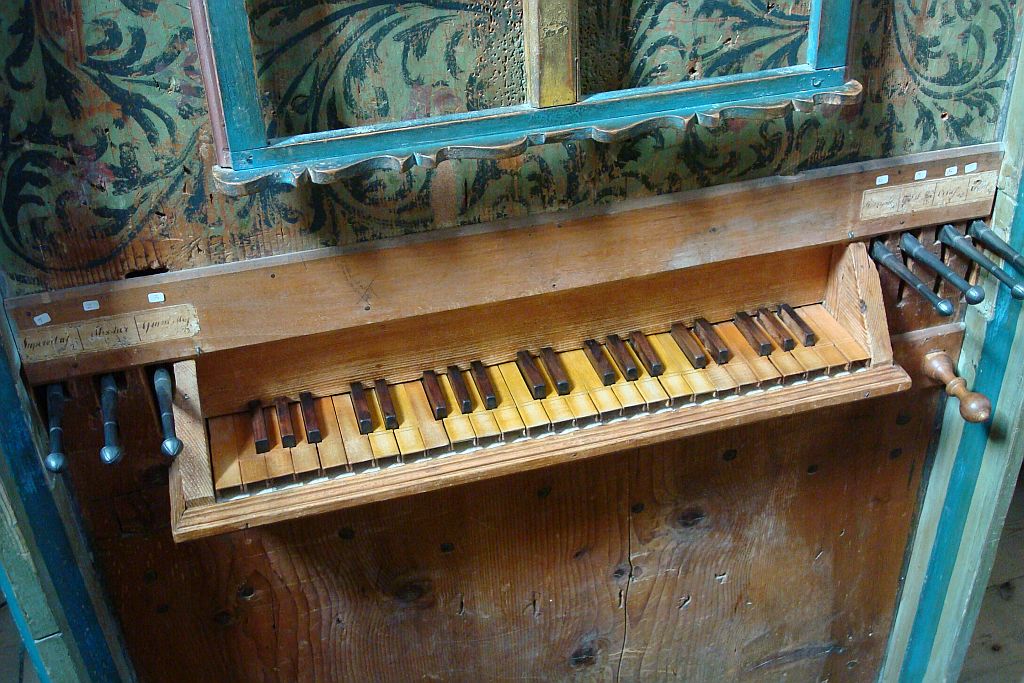Sion, Basilique Notre-Dame de Valère
| Builder | Anonymous |
|---|---|
| Year | ca. 1435 |
| Period/Style | Gothic |
| Stops | 9 |
| Keyboards | 1+P |
| Keyaction | tracker/mechanical |
| Tuning | Equal at 497 Hz |
The organ was constructed by an unknown builder around 1435. This estimation is based on the timing of the casing's painting, which also aligns with Radiocarbon dating results. The organ likely had an original range of H-A2 and was comprised of a block with up to 18 pipes per tone. Its location in the so-called swallow's nest on the west wall appears to be original, even though its current form was probably modified during a renovation by Aebi. The case, including the wing doors painted by Peter Maggenberg and the Gothic tracery, has been preserved in its original form. Due to the enlarged wind chest, however, the doors can no longer be closed. Therefore, the exterior sides of the wings were removed and are now displayed separately. The metal pipes for the tones H-f2 of the Principal 8′, Octav 2′, Quint minor 11/3′, and the 1′-row of the mixture appear to have been preserved from the Gothic era, as they were cast from lead on sand. The fronts of the display pipes are covered with tin.
From 1686 to 1688, Christoph Aebi converted the organ into a Baroque instrument and expanded it. Looking towards the existing range, he renewed the keyboards and transformed the Gothic block into an instrument with mechanical pull-off action slide chests. The wind chests and the key action were also replaced in this process. Aebi extended the organ by four new stops, reusing some of the old pipes, which are still preserved today. The pedal, which was only attached in the late-Gothic instrument, was also redesigned by Aebi, but likely wasn't expanded until the 18th century with twice nine pipes. Until another major intervention in the organ in 1827, five repairs are documented. After this, the instrument fell into disrepair. As the organ increasingly deteriorated in the early 20th century, a mild restoration for the time was conducted by Orgelbau Kuhn in 1954.
From 1686 to 1688, Christoph Aebi converted the organ into a Baroque instrument and expanded it. Looking towards the existing range, he renewed the keyboards and transformed the Gothic block into an instrument with mechanical pull-off action slide chests. The wind chests and the key action were also replaced in this process. Aebi extended the organ by four new stops, reusing some of the old pipes, which are still preserved today. The pedal, which was only attached in the late-Gothic instrument, was also redesigned by Aebi, but likely wasn't expanded until the 18th century with twice nine pipes. Until another major intervention in the organ in 1827, five repairs are documented. After this, the instrument fell into disrepair. As the organ increasingly deteriorated in the early 20th century, a mild restoration for the time was conducted by Orgelbau Kuhn in 1954.
| Manualwerk | Pedalwerk |
|---|---|
| Principal 8' | Subbass 16' |
| Octav 4' | Subbass 8' |
| Coppel 4' | |
| Quint major 2 2/3' | |
| Octav 2' | |
| Quint minor 1 1/3' | |
| Mixtur II |
https://organindex.de/index.php?title=Sion,_Basilique_de_Val%C3%A8re
 Pipe Organ Map
Pipe Organ Map
